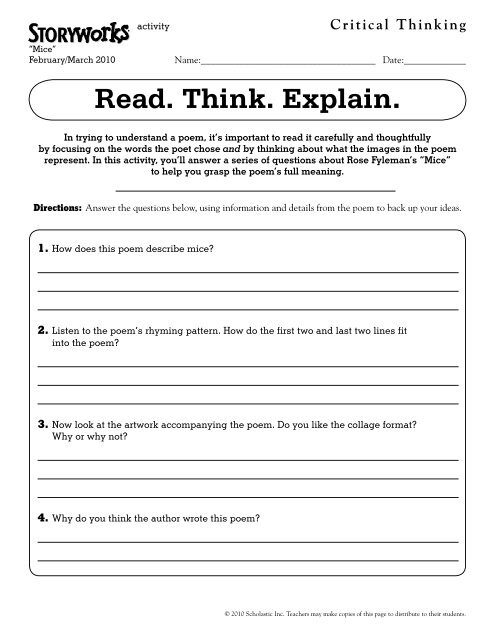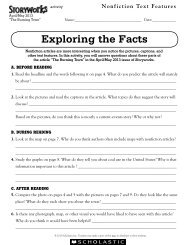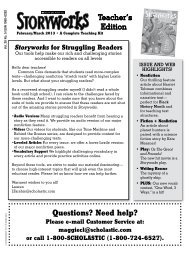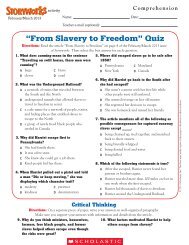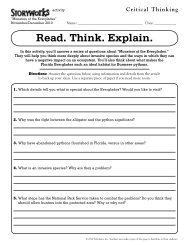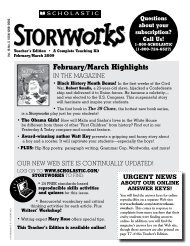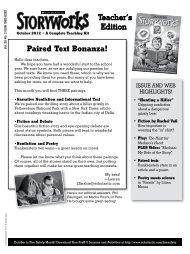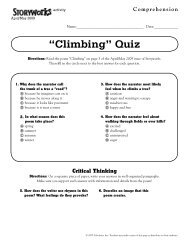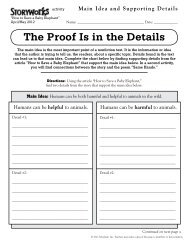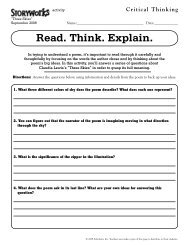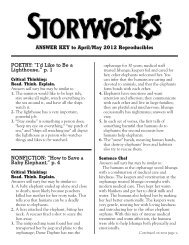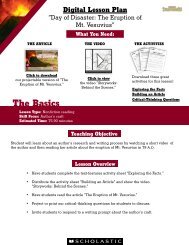Read. Think. Explain. - Scholastic
Read. Think. Explain. - Scholastic
Read. Think. Explain. - Scholastic
You also want an ePaper? Increase the reach of your titles
YUMPU automatically turns print PDFs into web optimized ePapers that Google loves.
“Mice”<br />
February/March 2010<br />
activity<br />
Critical <strong>Think</strong>ing<br />
Name:____________________________________ Date:_____________<br />
<strong>Read</strong>. <strong>Think</strong>. <strong>Explain</strong>.<br />
In trying to understand a poem, it’s important to read it carefully and thoughtfully<br />
by focusing on the words the poet chose and by thinking about what the images in the poem<br />
represent. In this activity, you’ll answer a series of questions about Rose Fyleman’s “Mice”<br />
to help you grasp the poem’s full meaning.<br />
Directions: Answer the questions below, using information and details from the poem to back up your ideas.<br />
1. How does this poem describe mice?<br />
2. Listen to the poem’s rhyming pattern. How do the first two and last two lines fit<br />
into the poem?<br />
3. Now look at the artwork accompanying the poem. Do you like the collage format?<br />
Why or why not?<br />
4. Why do you think the author wrote this poem?<br />
© 2010 <strong>Scholastic</strong> Inc. Teachers may make copies of this page to distribute to their students.
“Mice”<br />
February/March 2010<br />
activity<br />
Name:____________________________________ Date:_____________<br />
Fill-in-the-Blank Poetry<br />
Poetry Writing<br />
In her fun rhyming poem, Rose Fyleman uses simple language to describe a<br />
not-so-likable animal: a mouse. Can you think of other animals a lot of people dislike?<br />
Are there any unpopular animals that you “think are nice”? In this activity, we will help you<br />
write your own poem about an unpopular animal that you like.<br />
Directions: <strong>Read</strong> “Mice” again. Then fill in the blanks below with your own ideas, using Rose Fyleman’s poem as<br />
your guide. For an extra challenge, try following the rhyming pattern. Copy your finished poem<br />
onto a separate piece of paper. Feel free to make an artistic collage to illustrate your animal too!<br />
I think ____________________<br />
Name your animal.<br />
Are rather ____________________.<br />
____________________ by __________________<br />
Write a word that describes how you feel about your animal.<br />
Their ____________________ are ____________________,<br />
Their faces ____________________,<br />
They haven’t any<br />
____________________ at all.<br />
Their ____________________ are ____________________,<br />
Their ____________________ are ____________________,<br />
But I think ____________________<br />
Are ______________.<br />
Write the same word you used above.<br />
Name your animal.<br />
Your animal here<br />
Name a body part.<br />
They ____________________ about<br />
The ____________________ at night.<br />
They ____________________ things<br />
They shouldn’t touch.<br />
And no one seems<br />
To like them much.<br />
Your name here<br />
Describe the size or shape of your animal’s face.<br />
What physical characteristic does your animal seem to be missing?<br />
Name another body part. Describe what they look like.<br />
Name a third body part.<br />
verb<br />
Where do they live?<br />
verb<br />
Describe what they look like.<br />
Describe what they look like.<br />
© 2010 <strong>Scholastic</strong> Inc. Teachers may make copies of this page to distribute to their students.
“The Dark”<br />
February/March 2010<br />
activity<br />
Critical <strong>Think</strong>ing<br />
Name:____________________________________ Date:_____________<br />
<strong>Read</strong>. <strong>Think</strong>. <strong>Explain</strong>.<br />
In trying to understand a poem, it’s important to read it carefully and thoughtfully<br />
by focusing on the words the poet chose and by thinking about what the images in the poem<br />
represent. In this activity, you’ll answer a series of questions about Myra Cohn Livingston’s<br />
“The Dark” to help you grasp the poem’s full meaning.<br />
Directions: Answer the questions below, using information and details from the poem to back up your ideas.<br />
1. What do you notice about the poem’s rhythm? Why do you think the lines from<br />
“call” to “hide” are short?<br />
2. Look at the artwork accompanying the poem. Do you think the artist did a good job in<br />
capturing the mood? Why or why not?<br />
3. Why do you think darkness can seem scary?<br />
4. How does the narrator reassure herself that things are all right?<br />
© 2010 <strong>Scholastic</strong> Inc. Teachers may make copies of this page to distribute to their students.
“The Dark”<br />
February/March 2010<br />
activity<br />
Poetry Writing<br />
Name:____________________________________ Date:_____________<br />
Poet’s Craft<br />
Who hasn’t been afraid of scary creaks and pops in the night? In her poem “The Dark,”<br />
Myra Cohn Livingston uses a lot of simple words and phrases to make the feelings of night-<br />
time, being scared, and being in the dark come alive. In this activity, you’ll think about why the<br />
language Myra uses is so powerful. You’ll also practice coming up with words on your own.<br />
Directions: In the poem on the left, circle all the words and phrases that you associate with nighttime,<br />
being in the dark, or being scared of the dark. Then write them in the word bank to the right.<br />
It’s always<br />
dark<br />
around my bed<br />
and darkest<br />
where I put my head;<br />
and there are nights<br />
when strange sounds<br />
call<br />
inside<br />
the hollow<br />
of the wall<br />
and creaking noises<br />
from inside<br />
the closet<br />
where<br />
the<br />
nightmares<br />
hide;<br />
so after I have said<br />
my prayers<br />
and hear them<br />
talking from<br />
downstairs,<br />
I look around<br />
so I can see<br />
where everything<br />
I know should be—<br />
especially<br />
along the floor,<br />
the crack of light<br />
beneath the door.<br />
Word Bank<br />
Continued8<br />
© 2010 <strong>Scholastic</strong> Inc. Teachers may make copies of this page to distribute to their students.
activity<br />
Poet’s Craft page 2<br />
Critical <strong>Think</strong>ing<br />
1. Now pick something you are afraid of and write it below. (It can be a noun—like spiders or snakes—or a<br />
feeling, like freaking out about being in a crowded room full of noisy people.)<br />
2. Then brainstorm a list of words or phrases that describe your fear and write them in the word bank<br />
below. Ask yourself these questions if you need help: What does it feel like when I’m afraid? Are there<br />
sounds associated with the fear? Sights? Smells? A specific place?<br />
Word Bank<br />
Extra Credit!<br />
Now try writing a short poem about your fear, using the words and phrases you picked above.<br />
You can use Myra Cohn Livingston’s “The Dark” for inspiration.<br />
© 2010 <strong>Scholastic</strong> Inc. Teachers may make copies of this page to distribute to their students.
activity<br />
Critical <strong>Think</strong>ing<br />
“The Volcano at the End of the Earth”<br />
February/March 2010<br />
Name:____________________________________ Date:_____________<br />
<strong>Read</strong>. <strong>Think</strong>. <strong>Explain</strong>.<br />
In this activity, you’ll answer a series of questions about “The Volcano at the End of the Earth,”<br />
which will help you think more deeply about the author’s treacherous voyage to Antarctica to<br />
photograph Mount Erebus. You’ll also think about Barbara Johns and her personal reasons for<br />
visiting Antarctica to honor her father.<br />
Directions: Answer the questions below, using information and details from the article to back up your ideas.<br />
Use a separate piece of paper if you need more room for your answers.<br />
1. Why did Donna O’Meara travel to Antarctica? Would you like a job similar to hers?<br />
Why or why not?<br />
2. Why was Barbara Johns on her way to Antarctica? When and why did her father go there?<br />
3. What metaphor does the author use to describe Mount Erebus? What simile does she use<br />
to describe the ice crystals in the air? Do these literary devices help you envision what she<br />
saw?<br />
4. How do you think Donna O’Meara felt in Scott’s hut? How do you think Barbara Johns<br />
would have felt?<br />
5. What do you think were Donna O’Meara’s overall impressions of Antarctica?<br />
© 2010 <strong>Scholastic</strong> Inc. Teachers may make copies of this page to distribute to their students.
Sentence 1:<br />
Sentence 2:<br />
Sentence 3:<br />
Sentence 4:<br />
activity<br />
Vocabulary<br />
“The Volcano at the End of the Earth”<br />
February/March 2010<br />
Name:____________________________________ Date:_____________<br />
Lava Language<br />
This issue’s nonfiction article “The Volcano at the End of the Earth” includes some cool<br />
(both chilly and fun!) words. Don’t let the words freeze you up! In this activity, you will use a<br />
dictionary to match the words below to their definitions.<br />
Directions: Match each word on the left to its definition on the right.<br />
Then choose four of the words and write a sentence using each one.<br />
aptly made to feel peaceful, safe, or sleepy<br />
frigid extremely cold<br />
itinerary walked unsteadily<br />
lulled dangerous<br />
pitched suitably<br />
staggered the highest point<br />
summit plunged forward<br />
treacherous schedule for a journey<br />
© 2010 <strong>Scholastic</strong> Inc. Teachers may make copies of this page to distribute to their students.
© 2010 <strong>Scholastic</strong> Inc. Teachers may make copies of this page to distribute to their students.<br />
activity<br />
Fact/Opinion<br />
“The Volcano at the End of the Earth”<br />
February/March 2010<br />
Name:____________________________________ Date:_____________<br />
A-MAZING Facts & Opinions<br />
A fact is a statement that can be proved correct. An opinion is a statement that expresses<br />
what somebody thinks or feels about a topic. “The Volcano at the End of the Earth” is full of facts<br />
and opinions. In this activity, you will try to tell the difference between facts and opinions.<br />
Directions: <strong>Read</strong> each bubble below and decide which are facts and which are opinions. Then, circle all the<br />
bubbles that contain facts. Draw a line through the maze, connecting<br />
Donna was lucky<br />
to find a berth on<br />
Spirit of<br />
Enderby.<br />
Robert Falcon<br />
Scott's expedition<br />
was tragic.<br />
Donna O'Meara is<br />
a volcano<br />
photographer and<br />
explorer.<br />
The voyage to<br />
Antarctica was<br />
terrifying.<br />
Robert Falcon<br />
Scott's hut still<br />
stands to this<br />
day.<br />
Barbara Johns<br />
died on the trip to<br />
Antarctica.<br />
Donna's cabin<br />
smelled like burned<br />
motor oil.<br />
Barbara would<br />
have wanted<br />
Donna to continue<br />
the journey.<br />
%<br />
each bubble that contains a fact. You’ll know you’ve done the<br />
activity correctly when you reach the camera!<br />
Barbara<br />
Johns's son<br />
thought she<br />
was brave.<br />
Donna has<br />
photographed<br />
75 volcanoes.<br />
Antarctica is<br />
the fifth-largest<br />
continent.<br />
Mount Erebus was<br />
a giant, sparkling<br />
castle.<br />
Barbara Johns<br />
shouldn't have taken<br />
such a risky trip.<br />
Donna took great<br />
photos of Mount<br />
Erebus.<br />
Few<br />
commercial<br />
jets fly to<br />
Antarctica.<br />
Scott's<br />
famous hut<br />
was rustic.<br />
Mount Erebus is<br />
located on Ross<br />
Island.<br />
Mount Erebus is one of the most<br />
active volcanoes on the globe.<br />
Diamond dust<br />
is aptly named.<br />
Edward Nelson<br />
traveled to<br />
Antarctica in<br />
1910.
activity<br />
The Volcano at the End of the Earth<br />
February/March 2010<br />
Sequencing<br />
Name:____________________________________ Date:_____________<br />
A Long Journey<br />
Donna O’Meara’s article about visiting Antarctica is jam-packed with great facts and stories. She<br />
even includes history about exploring the continent. To help you keep track of all the information,<br />
try creating a timeline of events. In this activity, you will put events from the story in order.<br />
Directions: <strong>Read</strong> “The Volcano at the End of the Earth.” Then look at the events listed in the box below. Write<br />
the events in order from earlier to latest, starting on the lower left. We did the first one for you.<br />
B<br />
A. Donna O’Meara begins photographing Mount Erebus. F. Donna O’Meara flies to New Zealand.<br />
B. Robert Scott begins an expedition to Antarctica. G. Edward Nelson is rescued from Antarctica.<br />
C. The Spirit of Enderby encounters a terrible storm. H. Donna O’Meara meets Barbara Johns.<br />
D. Robert Scott and four of his men die in Antarctica. I. Roald Amundsen reaches the South Pole.<br />
E. Donna O’Meara books a berth on the J. Donna O’Meara visits Robert Scott’s hut.<br />
Spirit of Enderby.<br />
© 2010 <strong>Scholastic</strong> Inc. Teachers may make copies of this page to distribute to their students.
Micro-Mystery<br />
February/March 2010<br />
activity<br />
1. THE ACCUSATION<br />
In the last paragraph, I say, “I assure you the thief is not a member of our class . . . or our species!” Why?<br />
2. YOUR SUSPICIONS ABOUT THE SETTING<br />
What is unusual about the temperature of the classroom on that February morning? Why is this detail<br />
important?<br />
What sound do my classmates hear as they work on their fractions? Why is this important?<br />
Are there leaves on the trees? What conclusion can you draw from this fact?<br />
<strong>Read</strong>ing for Detail<br />
Name:____________________________________ Date:_____________<br />
Detective’s Notebook<br />
Imagine that you are a detective-in-training, learning from the great Owen Watts.<br />
Sure, he’s a snoop, but he’s a pro at solving mysteries. Owen keeps his thoughts organized<br />
in his head, but many detectives record their observations in a notebook to get themselves<br />
in the habit of paying attention to detail. Doing this also helps them keep track of little things<br />
that might turn out to be important later. To help you see how he solves his cases, Owen has<br />
provided the prompts below for your own “detective’s notebook.”<br />
Try this<br />
with a<br />
partner!<br />
Directions: <strong>Read</strong> “Owen Watts and the Fishy Prankster” one time. Then go back and read it again,<br />
filling in as much as you can below. You don’t need to write in complete sentences—just get the information<br />
down clearly. Finally, review your notes. Can you crack the case?<br />
Continued8<br />
© 2010 <strong>Scholastic</strong> Inc. Teachers may make copies of this page to distribute to their students.
Micro-Mystery<br />
February/March 2010<br />
activity<br />
<strong>Read</strong>ing for Detail<br />
Name:____________________________________ Date:_____________<br />
Detective’s My Ride, Notebook, Your Ride page 2<br />
3. OTHER CLUES<br />
What are some things I am allergic to? Why is this list important?<br />
My friend Claire’s eraser disappeared from her desk. Is there something specific about this eraser that<br />
makes it different from other erasers? What do you think happened to it?<br />
Mrs. Washington’s sandwich is on her desk, but something is wrong with it. What?<br />
What do you think might have happened to Mrs. Washington’s sandwich?<br />
4. YOUR DEDUCTIONS<br />
Write down the FIVE clues that point to the thief.<br />
5. YOUR SOLUTION<br />
Who (or what) is the thief?<br />
DETECTIVE’S GLOSSARY<br />
deduction [di-DUHK-shuhn]: something that is figured out from clues<br />
accusation [ak-yoo-ZEY-shun]: saying that someone has done something wrong<br />
suspicion [suh-SPISH-uhn]: a thought that something is wrong or bad<br />
© 2010 <strong>Scholastic</strong> Inc. Teachers may make copies of this page to distribute to their students.
“Yesterday & Today”<br />
February/March 2010<br />
activity<br />
Critical <strong>Think</strong>ing<br />
Name:____________________________________ Date:_____________<br />
<strong>Read</strong>. <strong>Think</strong>. <strong>Explain</strong>.<br />
In trying to understand an article, it’s important to read it carefully and thoughtfully, focusing<br />
on the words the author chose and thinking about the article’s big ideas. In this activity, you’ll<br />
answer a series of questions about airplane travel in its first decades and today. Then you’ll<br />
discuss how flying has changed and how it has stayed the same.<br />
Directions: Answer the questions below, using information and details from the article to back up your ideas.<br />
1. What were some disadvantages of early air travel?<br />
2. What changes to air travel came about as a result of World War II? Why do you think these<br />
changes were made?<br />
3. Do you think it is more of a positive or a negative that the government gave up its control of<br />
air travel? <strong>Explain</strong>.<br />
4. In earlier decades, flying on an airlplane was a special event. Do you think it still is?<br />
Why or why not?<br />
5. If your family wanted to make a long-distance trip from your home, what do you think<br />
would be the most convenient mode of transportation to take? Why?<br />
© 2010 <strong>Scholastic</strong> Inc. Teachers may make copies of this page to distribute to their students.
“Yesterday & Today”<br />
February/March 2010<br />
In this activity, you will compare and contrast the early days of commercial air travel<br />
and the crowded planes we take today, using this month’s “Yesterday & Today” feature.<br />
Directions: In the left box, write five facts about early airplane travel from the “Yesterday & Today” article.<br />
In the box on the right, write five facts about what flying is like in 2009.<br />
1.<br />
2.<br />
3.<br />
4.<br />
5.<br />
activity<br />
Facts<br />
Early Air Travel Plane Flights in 2009<br />
Critical <strong>Think</strong>ing<br />
Use your list to write a well-organized paragraph that explains how commercial air travel has changed<br />
from the early twentieth century to today. (Use a separate piece of paper.)<br />
1.<br />
2.<br />
3.<br />
4.<br />
5.<br />
Compare & Contrast<br />
Name:____________________________________ Date:_____________<br />
Five & Five<br />
© 2010 <strong>Scholastic</strong> Inc. Teachers may make copies of this page to distribute to their students.
“A Week in Texas”<br />
February/March 2010<br />
activity<br />
Critical <strong>Think</strong>ing<br />
Name:____________________________________ Date:_____________<br />
<strong>Read</strong>. <strong>Think</strong>. <strong>Explain</strong>.<br />
An active reader always looks for deeper meaning in a story.<br />
In this activity, you’ll answer questions about Tom, the main character in Watt Key’s adventurous tale<br />
“A Week in Texas.” You’ll also think about how Tom’s feelings about his cousins—and spending a<br />
week with them at their ranch doing wild and crazy things—change throughout the story.<br />
Directions: Answer the questions below, using information and details from the story<br />
to back up your ideas. Use a separate piece of paper if you need more room.<br />
1. Why does Tom object when his father tells him he will be going to Texas for a week?<br />
2. How does Tom feel as he rides with Uncle Bob in his truck? When they arrive at the ranch?<br />
What is the same or different from what he expected?<br />
3. What do you think goes through Tom’s head when Frank says they can “ride in the<br />
football”? How does he feel when he finds out what it means?<br />
4. Why does Tom agree to ride in the football and on the calf? How does watching his cousins<br />
do these things change his opinion of them?<br />
5. Tom expected his week in Texas to be boring. How do you think he would describe the visit<br />
after his first day there?<br />
© 2010 <strong>Scholastic</strong> Inc. Teachers may make copies of this page to distribute to their students.
“A Week in Texas”<br />
February/March 2010<br />
activity<br />
Vocabulary<br />
Name:____________________________________ Date:_____________<br />
Thesaurus Rex<br />
Great writers fill their stories with words that fit just right. But you won’t want to<br />
use the same vocabulary every time. Sometimes, a flashier word works perfectly;<br />
other times, a commonly used word does the trick. In this activity, you’ll use a<br />
thesaurus or a dictionary to find synonyms for words from the story.<br />
Directions: Using a thesaurus or a dictionary, find and write a common synonym<br />
above each word and a less common one below it.<br />
bucking<br />
escorted<br />
lumbering<br />
lush<br />
pudgy<br />
stunted<br />
Critical <strong>Think</strong>ing<br />
On a separate piece of paper, write two short letters from Tom, describing his trip. Write one to a young friend<br />
in Crystal Bay, using the common words you listed above. Write the other letter to Tom’s parents, using the<br />
tougher words. In each letter, make sure you use at least four of the synonyms you recorded above.<br />
© 2010 <strong>Scholastic</strong> Inc. Teachers may make copies of this page to distribute to their students.
activity<br />
Critical <strong>Think</strong>ing/<strong>Read</strong>er Response<br />
“A Week in Texas”<br />
February/March 2010 Name: ____________________________________ Date: _____________<br />
What Did You <strong>Think</strong> of<br />
“A Week in Texas”?<br />
Directions: <strong>Read</strong> the fiction story “A Week in Texas” in the February/March 2010 issue of Storyworks.<br />
Then on a separate piece of paper, rewrite these paragraphs, filling in the blanks with details from the story and<br />
with your own ideas. When you are finished, you will have a well-crafted review of Watt Key’s story.<br />
I just read “A Week in Texas” by Watt Key. The _______________ story is about a boy named<br />
_______________ who is forced to spend a week in Texas instead of staying in _______________,<br />
Name the main character. Name the town and state.<br />
where he lives. At first, he feels _______________ about having to go. He’d rather _______________<br />
and _______________ at home than _______________ on his cousins’ Texas ranch. That experience<br />
List another activity.<br />
sounded like it would be _______________. But when he gets there, Tom is pleasantly surprised.<br />
Summarize what Tom thinks<br />
the experience will be like.<br />
The minute Tom sees his cousins, _______________ and _______________, they invite him to<br />
do something _______________. Instead of watching TV, they _______________! Tom describes<br />
Choose an adjective that<br />
describes the activity.<br />
the experience this way: _______________. As if things couldn’t get any crazier, the kids then decide<br />
to _______________. At the end of his turn, Tom’s face lands in _______________. Gross! But he<br />
Describe what happens next.<br />
Choose an adjective to<br />
describe how he feels.<br />
<strong>Explain</strong> how Tom feels<br />
about the experience.<br />
Name an activity he might<br />
take part in on the ranch.<br />
Name one cousin.<br />
Choose an adjective<br />
to describe the story.<br />
<strong>Explain</strong> what they<br />
decide to do.<br />
Tell what his face lands in.<br />
doesn’t care. He realizes that _______________. And he learns a valuable lesson: _______________.<br />
Tell what he realizes<br />
about his cousins.<br />
Overall, I thought this story was _______________ because _______________. The situation<br />
Give your opinion. Back up your opinion.<br />
reminded me of something that happened to me: _______________. If I had to choose whether<br />
Connect Tom’s situation to<br />
something in your life.<br />
Name the other cousin.<br />
to recommend this story to my friends, I _______________ because _______________.<br />
would/would not Back up your opinion.<br />
List one activity he<br />
likes to do at home.<br />
<strong>Explain</strong> the lesson he learns.<br />
© 2010 <strong>Scholastic</strong> Inc. Teachers may make copies of this page to distribute to their students.
“A Week in Texas”<br />
February/March 2010<br />
activity<br />
Understanding Setting<br />
Name:______________________________ Date:_____________<br />
A Week Where?<br />
In Watt Key’s short story “A Week in Texas,” Tom does not want to leave Crystal Bay, Alabama,<br />
for a vacation in Texas. But the setting of the story, the ranch in Texas, is so important to the tale<br />
that it becomes like a character itself. In this activity, you will think about how the setting in<br />
“A Week in Texas” affects the story.<br />
Directions: Answer the questions below to explore the setting in “A Week in Texas.”<br />
1. What does Texas look like in the story? How does Tom describe his surroundings when he arrives?<br />
_____________________________________________________________________________________<br />
_____________________________________________________________________________________<br />
2. How does the setting affect Tom’s cousins, who grew up on the ranch? List three details that<br />
describe their life there. (Hint: How do Frank and Caroline have fun? What do they know how to do?)<br />
_____________________________________________________________________________________<br />
_____________________________________________________________________________________<br />
_____________________________________________________________________________________<br />
3. How does the setting affect Tom? How is his life different in Texas than in Alabama? ___________<br />
_____________________________________________________________________________________<br />
___________________________________________________________________________________<br />
4. After reading this story, what do you think Texas is like? Have you ever been there? If so, did the<br />
story describe it accurately? _____________________________________________________________<br />
_____________________________________________________________________________________<br />
_____________________________________________________________________________________<br />
On Your Own<br />
Imagine you’re spending a week in Texas. Write a<br />
postcard describing how your life is different there<br />
than it is at home. Draw a picture on the front.<br />
With a Partner<br />
Pick one partner to stand for Texas and the other<br />
for Alabama. Make a list of activities for each state<br />
and have a debate about who has the most fun.<br />
© 2010 <strong>Scholastic</strong> Inc. Teachers may make copies of this page to distribute to their students.
“A Week in Texas”<br />
February/March 2010<br />
activity<br />
Writers’ Workshop: Descriptive<br />
Details<br />
Name:____________________________________ Date:_____________<br />
Secrets From Great Writers!<br />
THIS ISSUE’S SECRET: USE THE FIVE SENSES<br />
In the story “A Week in Texas,” Watt Key uses the five senses to write amazing descriptions and<br />
action sequences. You would swear that you are right there with Tom and his cousins, horsing<br />
around at the dusty ranch. In this activity, you will think about how Watt Key writes such lively<br />
descriptions. You will then write your own using his technique.<br />
Directions: <strong>Read</strong> the passage below, from “A Week in Texas,” by Watt Key.<br />
Then follow the prompts.<br />
In “A Week in Texas,” Watt Key describes what it’s like to spend a week goofing around and having a<br />
good time on a dusty ranch in Texas. Instead of just writing, “We chased farm animals in the backyard and it<br />
was a lot of fun,” he creates an amazingly vivid scene that comes alive in readers’ minds.<br />
Watt Key writes:<br />
I started running. I leapt onto the back of the closest calf and clutched it like a wet cat. For a few seconds,<br />
everything was a bucking blur, with the wind roaring in my face. Suddenly, I knew the calf was no longer<br />
under me. When I hit the ground, it felt like I’d been slapped on the rear with a board. My face rolled through<br />
something soft and slimy. Finally, I came to rest, staring up at the clear Texas sky.<br />
Mr. Key’s Trick: Notice that he mentions three of the five senses—what Tom sees, hears, and touches—<br />
to describe the scene. (And I bet you can infer what Tom smelled at the time!) He also uses similes to make<br />
the action stand out even more.<br />
NOW, YOU TRY IT!<br />
1. I dove into the lake. (Hint: What did the lake look like? Was the splash loud? What did it feel like?)<br />
Continued<br />
© 2010 <strong>Scholastic</strong> Inc. Teachers may make copies of this page to distribute to their students.
“A Week in Texas”<br />
February/March 2010<br />
2. I ate a peach for lunch. (Hint: What did it taste like? Was it sticky? Did it make a sucking sound?<br />
Did it drip on your shirt?)<br />
3. The clown sang for the birthday party.<br />
4. The volcano erupted.<br />
activity<br />
Writers’ Workshop: Descriptive<br />
Details<br />
Secrets From Great Writers! page 2<br />
5. Write a paragraph describing a time you and your cousins (or friends) did something that was wild and fun.<br />
© 2010 <strong>Scholastic</strong> Inc. Teachers may make copies of this page to distribute to their students.
March for Freedom<br />
February/March 2010<br />
activity<br />
Critical <strong>Think</strong>ing<br />
Name:____________________________________ Date:_____________<br />
<strong>Read</strong>. <strong>Think</strong>. <strong>Explain</strong>.<br />
Dr. Martin Luther King Jr.’s “I Have a Dream” speech is one of the most famous in history. And<br />
the March on Washington in 1963 was a day on which people of all races and backgrounds came<br />
together to fight for freedom. In this activity, you’ll answer questions about these subjects in<br />
March for Freedom, to better understand their significance in history.<br />
Directions: Answer the questions below, using information and details from the play to back up your ideas.<br />
1. Why is Dad upset at the beginning of the play? Why is James upset?<br />
2. James explains that Dr. King preaches nonviolence. What are some ways that people<br />
protest nonviolently?<br />
3. Why were organizers worried about the march at the beginning? What ended up<br />
happening?<br />
4. What do Clay’s and Erik’s journeys tell you about the march?<br />
5. Based on the text of the speech, what was Dr. Martin Luther King Jr.’s dream?<br />
© 2010 <strong>Scholastic</strong> Inc. Teachers may make copies of this page to distribute to their students.
March for Freedom<br />
February/March 2010<br />
activity<br />
Civil Rights Vocabulary<br />
Name:____________________________________ Date:_____________<br />
Say It Loud<br />
This issue’s play takes readers to a major moment in the civil rights movement. It also uses words<br />
and phrases that are important to understanding the era and its events. In this activity, you will<br />
learn the definitions of civil rights vocabulary and use the words to complete protest signs.<br />
Directions: <strong>Read</strong> March for Freedom. Match the civil rights term on the left to its definition on the right. Then<br />
read the signs below and choose the correct term to fill in each blank. Write your own slogan on the last sign.<br />
Civil Rights Act public gatherings where people voice beliefs<br />
demonstrations open to people of all races<br />
Emancipation Proclamation having separate facilities for whites and non-whites<br />
integrated document signed in 1863 freeing slaves<br />
nonviolence 1964 law prohibiting racial discrimination<br />
segregation peaceful approach to making social changes<br />
WE BELIEVE IN<br />
__________________<br />
NOT IN<br />
BACKING DOWN.<br />
The _________ _________<br />
says everyone is free.<br />
So why aren’t we free to sit,<br />
eat, and learn together?<br />
OUR SCHOOLS SHOULD BE<br />
______________!<br />
END __________ NOW!<br />
© 2010 <strong>Scholastic</strong> Inc. Teachers may make copies of this page to distribute to their students.
March for Freedom<br />
February/March 2010<br />
Try this<br />
with a<br />
partner!<br />
activity<br />
Conflict/Resolution<br />
Name:____________________________________ Date:_____________<br />
March for Resolutions<br />
In March for Freedom, Mack Lewis writes about many of the problems people faced<br />
during the civil rights era. He also writes about some of the steps people took to solve them.<br />
In this activity, you’ll practice your own conflict-resolving skills to better understand<br />
Mack Lewis’s powerful play about that historic time.<br />
Directions: As you read March for Freedom, write a list in the first column below of the conflicts<br />
characters face. In the next column, jot down how they resolved them. Then think about what<br />
you would’ve done if you were in their shoes. Record these ideas in the third column.<br />
We’ve done the first one for you.<br />
CONFLICT RESOLUTION MY RESOLUTION<br />
Mom wants Grandma to see<br />
a doctor. Grandma doesn’t<br />
want to.<br />
On Your Own<br />
Imagine you want to go to the march but can’t<br />
because of a conflict. Write a diary entry explaining<br />
your problem and how you might resolve it.<br />
Grandma makes a deal with<br />
Mom. She’ll go if her grandkids<br />
can go see Dr. King.<br />
Make the same deal.<br />
With a Partner<br />
Pretend you’re participants at the march. Decide<br />
which issue is the most important to you. Create a<br />
poster to show Dr. King, listing possible resolutions.<br />
© 2010 <strong>Scholastic</strong> Inc. Teachers may make copies of this page to distribute to their students.
February/March 2010<br />
aspect creed elated expedition gale<br />
hobbling lush pried reliable stunted<br />
1. long journey for a special purpose<br />
2. very strong wind<br />
3. trustworthy<br />
4. pulled apart using force<br />
5. guiding belief<br />
6. one feature of something<br />
7. very pleased<br />
8. walking with difficulty<br />
9. not growing properly<br />
activity<br />
10. growing thickly and healthily<br />
___ ___ ___ ___ ___ ___ ___ ___ ___ ___<br />
___ ___ ___ ___<br />
___ ___ ___ ___ ___ ___ ___ ___<br />
___ ___ ___ ___ ___<br />
___ ___ ___ ___ ___<br />
___ ___ ___ ___ ___ ___<br />
___ ___ ___ ___ ___ ___<br />
___ ___ ___ ___ ___ ___ ___ ___<br />
___ ___ ___ ___ ___ ___ ___<br />
___ ___ ___ ___<br />
Robert Falcon Scott led an expedition to Antarctica because<br />
he hoped to be the first person to reach<br />
ANSWER: ___ ___ ___ ___ ___ ___ ___ ___ ___ ___ ___ ___.<br />
7. 10. 2. 6. 8. 9. 1. 10. 4. 8. 3. 5.<br />
Vocabulary<br />
Name:____________________________________ Date:_____________<br />
Solve Vocab U. Larry’s Puzzle<br />
Larry found lots of great vocabulary words in the February/March 2010 issue<br />
of Storyworks. Use the words listed below to solve his puzzle.<br />
Directions: Choosing from the words in the bank below, find the synonym of each numbered word<br />
or phrase, and write it in the blanks next to it. One letter from each word will fall into the dotted oval.<br />
Use those letters to complete the sentence at the bottom of the page.<br />
© 2010 <strong>Scholastic</strong> Inc. Teachers may make copies of this page to distribute to their students.


